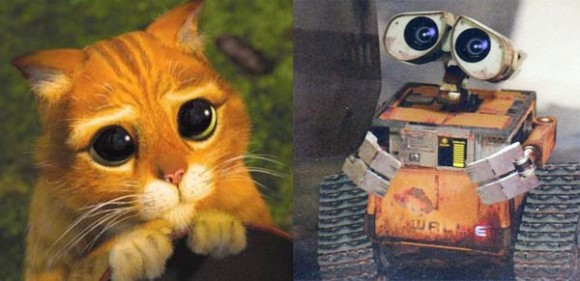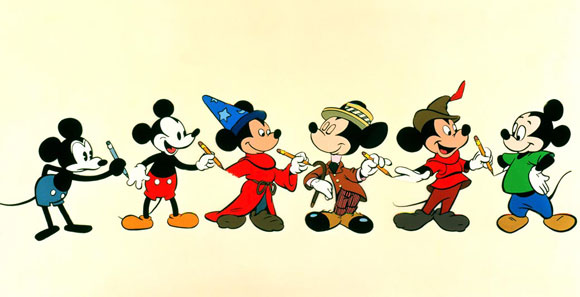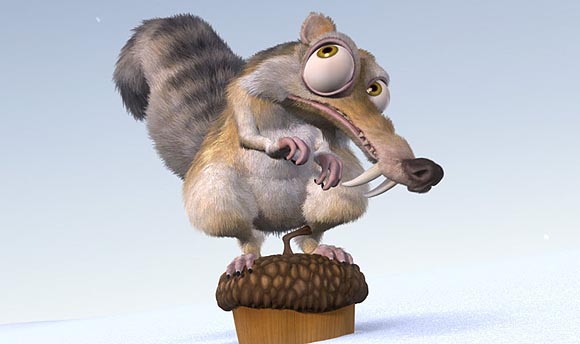The silver lining: Brad Bird is returning to animation.
Add a CommentViewing: Blog Posts Tagged with: Finding Nemo, Most Recent at Top [Help]
Results 1 - 7 of 7
Blog: Cartoon Brew (Login to Add to MyJacketFlap)
JacketFlap tags: Business, Disney, Disneyland, The Incredibles, Franchises, Finding Nemo, Bob Iger, Brad Bird, John Carter, Andrew Stanton, The Lone Ranger, Tomorrowland, Finding Dory, Add a tag
Blog: Cartoon Brew (Login to Add to MyJacketFlap)
JacketFlap tags: The New Yorker, The Little Prince, Ice Age, Finding Nemo, Peter de Sève, Hop, Arthur Christmas, Ice age: Continental Drift, Ice Age 4, Artist of the Day, A Bug's Life, Mulan, Art Students League, Ice Age: Dawn of the Dinosaurs, Parsons School of Design, Add a tag
Blog: Cartoon Brew (Login to Add to MyJacketFlap)
JacketFlap tags: The Incredibles, Finding Nemo, Brad Bird, Sarah Boxer, Feature Film, Educational, Add a tag
On a couple occasions throughout the years, people have asked me, Why do so many animated films have dead mothers in them?
Add a CommentBlog: Cartoon Brew (Login to Add to MyJacketFlap)
JacketFlap tags: Pixar, Clownfish, Finding Nemo, Add a tag
Pixar's "Finding Nemo" told of a touching bond between a clownfish father and son. But according to this fascinating excerpt from Stephen R. Palumbi and Anthony R. Palumbi's new book "The Extreme Life of the Sea", "Finding Nemo" director Andrew Stanton bypassed the most intriguing trait of clownfish, which is that they can change their sex. Had Pixar stayed true to clownfish biology, they would have ended up with a quite different story.
Add a CommentBlog: Cartoon Brew (Login to Add to MyJacketFlap)
JacketFlap tags: Denis Dutton, Preston Blair, Scrat, Peter Thaler, Stephen Jay Gould, WALL·E, Character Design, Ideas/Commentary, Cartoon Culture, Educational, Yoda, Trolls, Pixar, E.T., Ice Age, Finding Nemo, Add a tag

Over on question-and-answer website Quora, someone posted a very simple question: Which is the cutest cartoon character ever created? The answers from Quora members cover a broad spectrum, some more obvious (Tweety, Pokemon, Pooh) and others less so (Gertie the Dinosaur, Night Fury from How to Train Your Dragon).
So what makes a cartoon character cute? You could reduce the answer down to a few basic characteristics: big eyes and head, fluffiness, warmth and chubbiness. “Cuteness is based on the basic proportions of a baby plus the expressions of shyness or coyness,” wrote Preston Blair in Advanced Animation. According to Blair, other cute traits include:
- Head large in relation to the body.
- Eyes spaced low on the head and usually wide and far apart.
- Fat legs, short and tapering down into small feet for type.
- Tummy bulges—looks well fed.

But cuteness is far more complex than even Blair’s set of rules; some consider E.T., Yoda and WALL·E to be the epitome of cute, despite their furless, odd appearances. Cuteness and a character’s perceived hugability aren’t always determined by aesthetic appeal. “Cuteness is distinct from beauty,” wrote Natalie Angier for The New York Times. “Beauty attracts admiration and demands a pedestal; cuteness attracts affection and demands a lap.”
In essence, any creature deemed cute is one that speaks to our nurturing instincts. The cuteness of an infant can motivate an adult to take care of it, even if the baby is not a blood relation. Even more, studies have found that humans transfer these same emotions to animals (or even inanimate objects) that bear our similar features. Finding Nemo combined all of these psychological elements perfectly—you can’t hug or cuddle a fish, yet adorable Nemo, with his fin damaged from birth and his human-like facial features, appeals to our caregiving instincts. In fact, every character in Pixar films, whether it’s a clownfish or a car, features forward-facing eyes, the most crucial feature for achieving an emotional connection with the audience.
But with any extreme comes another. If a character is too cute and sugary sweet, the audience can develop skepticism. “Cute cuts through all layers of meaning and says, ‘Let’s not worry about complexities, just love me,’” philosopher Denis Dutton told The New York Times. It is for that very reason cuteness stirs uneasiness and sometimes feels cheap.
After all, the adorable, smiling face of a child can hide the havoc he just wreaked by breaking all of his toys. “Cuteness thus coexists in a dynamic relationship with the perverse,” writes Daniel Harris in his book Cute, Quaint, Hungry And Romantic: The Aesthetics Of Consumerism. You could call this the Gremlin Effect—a character with an underlying creepiness. Troll dolls (which were recently acquired by DreamWorks Animation) and Cabbage Patch Kids are the inexplicable result of this paradox.

There’s no denying a cultural need to pigeonhole and perfect the attributes that could be popularly deemed cute. In his fantastic short essay on Mickey Mouse, biologist and historian Stephen Jay Gould asserts that Mickey’s changing appearance over time is a physical evolution that mirrors cultural attitudes toward cuteness. As the Benjamin Button of animated rodentia, Mickey’s eyes and head have grown larger, his arms and legs chubbier. Mickey has become more childlike and, most would say, more cute and less rat-like. Mickey isn’t the only character to undergo this transformation. The teddy bear, first sold in 1903, started out anatomically similar to a real bear, with a long snout and gangly arms. Today’s teddy bears more closely resemble the Care Bears, with pudgier features and colorful fur.
Audience don’t always need Mickey’s goofy grins and huge eyes to connect with a character’s cuteness. Pictoplasma, the artists’ network and conference that celebrates characters extracted from context, reveals how sometimes it’s our own invented narrative that blasts a character into hall-of-fame cuteness. As Pictoplasma co-founder Peter Thaler said explains, “It’s a horrible example, but Hello Kitty has no facial expression. You don’t know if she’s happy or sad; you just see these two dots. You’re projecting all the narration, the biography.”

Our ideals of cuteness continue to evolve, a trajectory in visual culture that has birthed Hello Kitty and Japan’s kawaii movement, Giga Pets, Furby, Elmo and Slimer. Often the most exciting, memorable cute characters are the ones who bear negative traits that reveal the vulnerability. Scrat, the saber-toothed squirrel from Ice Age, is adorable and loved by audiences even more for his greed. Cuteness, perhaps then, is not just about an objective set of physical features—it’s also about a behavior that compels audiences and connects us emotionally to the character.
Add a CommentBlog: Cartoon Brew (Login to Add to MyJacketFlap)
JacketFlap tags: Finding Nemo, Denis Dutton, Preston Blair, Scrat, Peter Thaler, Stephen Jay Gould, WALL·E, Character Design, Ideas/Commentary, Educational, Yoda, Trolls, Pixar, E.T., Ice Age, Add a tag

Over on question-and-answer website Quora, someone posted a very simple question: Which is the cutest cartoon character ever created? The answers from Quora members cover a broad spectrum, some more obvious (Tweety, Pokemon, Pooh) and others less so (Gertie the Dinosaur, Night Fury from How to Train Your Dragon).
So what makes a cartoon character cute? You could reduce the answer down to a few basic characteristics: big eyes and head, fluffiness, warmth and chubbiness. “Cuteness is based on the basic proportions of a baby plus the expressions of shyness or coyness,” wrote Preston Blair in Advanced Animation. According to Blair, other cute traits include:
- Head large in relation to the body.
- Eyes spaced low on the head and usually wide and far apart.
- Fat legs, short and tapering down into small feet for type.
- Tummy bulges—looks well fed.

But cuteness is far more complex than even Blair’s set of rules; some consider E.T., Yoda and WALL·E to be the epitome of cute, despite their furless, odd appearances. Cuteness and a character’s perceived hugability aren’t always determined by aesthetic appeal. “Cuteness is distinct from beauty,” wrote Natalie Angier for The New York Times. “Beauty attracts admiration and demands a pedestal; cuteness attracts affection and demands a lap.”
In essence, any creature deemed cute is one that speaks to our nurturing instincts. The cuteness of an infant can motivate an adult to take care of it, even if the baby is not a blood relation. Even more, studies have found that humans transfer these same emotions to animals (or even inanimate objects) that bear our similar features. Finding Nemo combined all of these psychological elements perfectly—you can’t hug or cuddle a fish, yet adorable Nemo, with his fin damaged from birth and his human-like facial features, appeals to our caregiving instincts. In fact, every character in Pixar films, whether it’s a clownfish or a car, features forward-facing eyes, the most crucial feature for achieving an emotional connection with the audience.
But with any extreme comes another. If a character is too cute and sugary sweet, the audience can develop skepticism. “Cute cuts through all layers of meaning and says, ‘Let’s not worry about complexities, just love me,’” philosopher Denis Dutton told The New York Times. It is for that very reason cuteness stirs uneasiness and sometimes feels cheap.
After all, the adorable, smiling face of a child can hide the havoc he just wreaked by breaking all of his toys. “Cuteness thus coexists in a dynamic relationship with the perverse,” writes Daniel Harris in his book Cute, Quaint, Hungry And Romantic: The Aesthetics Of Consumerism. You could call this the Gremlin Effect—a character with an underlying creepiness. Troll dolls (which were recently acquired by DreamWorks Animation) and Cabbage Patch Kids are the inexplicable result of this paradox.

There’s no denying a cultural need to pigeonhole and perfect the attributes that could be popularly deemed cute. In his fantastic short essay on Mickey Mouse, biologist and historian Stephen Jay Gould asserts that Mickey’s changing appearance over time is a physical evolution that mirrors cultural attitudes toward cuteness. As the Benjamin Button of animated rodentia, Mickey’s eyes and head have grown larger, his arms and legs chubbier. Mickey has become more childlike and, most would say, more cute and less rat-like. Mickey isn’t the only character to undergo this transformation. The teddy bear, first sold in 1903, started out anatomically similar to a real bear, with a long snout and gangly arms. Today’s teddy bears more closely resemble the Care Bears, with pudgier features and colorful fur.
Audience don’t always need Mickey’s goofy grins and huge eyes to connect with a character’s cuteness. Pictoplasma, the artists’ network and conference that celebrates characters extracted from context, reveals how sometimes it’s our own invented narrative that blasts a character into hall-of-fame cuteness. As Pictoplasma co-founder Peter Thaler said explains, “It’s a horrible example, but Hello Kitty has no facial expression. You don’t know if she’s happy or sad; you just see these two dots. You’re projecting all the narration, the biography.”

Our ideals of cuteness continue to evolve, a trajectory in visual culture that has birthed Hello Kitty and Japan’s kawaii movement, Giga Pets, Furby, Elmo and Slimer. Often the most exciting, memorable cute characters are the ones who bear negative traits that reveal the vulnerability. Scrat, the saber-toothed squirrel from Ice Age, is adorable and loved by audiences even more for his greed. Cuteness, perhaps then, is not just about an objective set of physical features—it’s also about a behavior that compels audiences and connects us emotionally to the character.
Add a CommentBlog: Notes from the Slushpile (Login to Add to MyJacketFlap)
JacketFlap tags: Candy Gourlay, Writing Endings, Andrew Stanton, Writing, Shine, Finding Nemo, Add a tag
I have to exercise now to keep alive and when I'm gasping away in the privacy of my office, I like to listen to Director's Commentaries of my favourite movies. Today's director's commentary has got to be the best - Finding Nemo not only features the voices of director Andrew Stanton, co-director Lee Unkrich and co-writer Bob Peterson, but cuts away to details and mini documentaries about the



That's so interesting, and I would agree that you need to know your characters through and though to fully establish an ending. HOWEVER I must admit that I have found that sometimes there is a picture in my head, a scene, a dialogue that you know happens right at the end, and I have to write and rewrite and edit to get to know the characters & find out who is in it and why it is there!
This is so true! For me anyway - I always start the book journey with a fairly good idea of where I'm going but when I get there, so much detail has changed - strange things often happen that I couldn't have known about. I can not wait to read Shine.
And, you can't write the beginning until you know the whole book. How can you do the setup without knowing what it is you're setting up. That was the latest edit, planting the seeds that will blossom later. I love seeing this done visually in film. We caught the beginning of Ghostbusters the other day and as Sigourney Weaver emptied the shopping onto the counter at the beginning of the
This is my usual method: <br />1. write the first chapter, <br />2. write that last chapter, <br />3. write the middle, <br />4. rewrite the last chapter, <br />5. rewrite the first chapter, <br />6. rewrite the middle,<br />7. repeat 4 to 6 until run out of time....!<br />But quite seriously even though it may change the last chapter is usually one of the first things I write. I like to know
Good one Maureen. I find it really difficult to write outside the line of my narrative. I tend to begin at the beginning then work my way to the end. I get paralysed if there is something up ahead that's already created and complete because it doesn't feel like it's part of my storytelling!
Good method!I always know where I am going but I don't put it down because I need the energy of the whole book to write the best words for the finale!
Thanks Kathy ... I think I work like you. And I can't wait to read Shine either!
In Finding Nemo they said they always knew they would end with the going to school scene again. But they wanted to reprise the best bits of the film ... which they couldn't until they were done.
Do you plot everything out Teri?
How much plotting I do varies - have plotted book 3 quite heavily as I didn't have enough time to repeat steps 4 to 6 indefinitely. But I did write the ending first
Congratulations on finishing Shine, Candy! That must feel great. Can't wait to read it!<br /><br />So interesting to read about different working methods. Although I always have a general sense of how I want the story to end, I find I can't write the last scenes in any detail until a really late draft. I seem to always write several drafts where the ending is just a few notes, and it'
I didn't really understand what authors meant when they said that the characters wrote the book themselves. I used to think "How stupid. You're the author, you decide what happens." Then I wrote my first book. By the time I was only just into my second book I was beginning to wonder if I just bred very independent characters who paid little attention to what I said! I have
Oh that is so true! Mind you characters can be so annoying - always trying to wrest control of the story from you.
We are totally on the same wavelength, Helen. We should really be in the same critique group. Oh wait. We are!
Could you clarify guys by 'end' do you mean climax onwards of just the post climax denouement? Thanks :0)
Hmm both but especially post denouement ... after expending all that emotion at the climax, staying the course and writing well to the end is tough. I really notice it when books lose energy at the end as if the author just got on with tying up loose ends and let go of his/her magic wand.